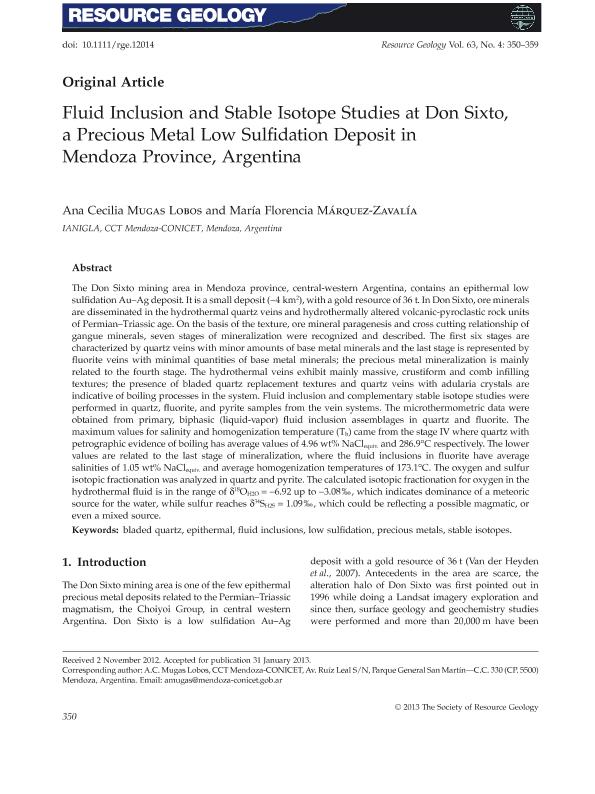Artículo
Fluid Inclusion and stable isotope studies at Don Sixto, a precious metal low sulfidation deposit in Mendoza province, Argentina
Fecha de publicación:
09/2013
Editorial:
Wiley Blackwell Publishing, Inc
Revista:
Resource Geology
ISSN:
1344-1698
Idioma:
Inglés
Tipo de recurso:
Artículo publicado
Clasificación temática:
Resumen
The Don Sixto mining area in Mendoza province, central-western Argentina, contains an epithermal low sulfidation Au-Ag deposit. It is a small deposit (∼4km2), with a gold resource of 36t. In Don Sixto, ore minerals are disseminated in the hydrothermal quartz veins and hydrothermally altered volcanic-pyroclastic rock units of Permian-Triassic age. On the basis of the texture, ore mineral paragenesis and cross cutting relationship of gangue minerals, seven stages of mineralization were recognized and described. The first six stages are characterized by quartz veins with minor amounts of base metal minerals and the last stage is represented by fluorite veins with minimal quantities of base metal minerals; the precious metal mineralization is mainly related to the fourth stage. The hydrothermal veins exhibit mainly massive, crustiform and comb infilling textures; the presence of bladed quartz replacement textures and quartz veins with adularia crystals are indicative of boiling processes in the system. Fluid inclusion and complementary stable isotope studies were performed in quartz, fluorite, and pyrite samples from the vein systems. The microthermometric data were obtained from primary, biphasic (liquid-vapor) fluid inclusion assemblages in quartz and fluorite. The maximum values for salinity and homogenization temperature (Th) came from the stage IV where quartz with petrographic evidence of boiling has average values of 4.96 wt% NaClequiv. and 286.9°C respectively. The lower values are related to the last stage of mineralization, where the fluid inclusions in fluorite have average salinities of 1.05 wt% NaClequiv. and average homogenization temperatures of 173.1°C. The oxygen and sulfur isotopic fractionation was analyzed in quartz and pyrite. The calculated isotopic fractionation for oxygen in the hydrothermal fluid is in the range of δ18OH2O = -6.92up to -3.08‰, which indicates dominance of a meteoric source for the water, while sulfur reaches δ34SH2S = 1.09‰, which could be reflecting a possible magmatic, or even a mixed source.
Archivos asociados
Licencia
Identificadores
Colecciones
Articulos(IANIGLA)
Articulos de INST. ARG. DE NIVOLOGIA, GLACIOLOGIA Y CS. AMBIENT
Articulos de INST. ARG. DE NIVOLOGIA, GLACIOLOGIA Y CS. AMBIENT
Citación
Mugas Lobos, Ana Cecilia; Marquez Zavalia, Maria Florencia; Fluid Inclusion and stable isotope studies at Don Sixto, a precious metal low sulfidation deposit in Mendoza province, Argentina; Wiley Blackwell Publishing, Inc; Resource Geology; 63; 4; 9-2013; 350-359
Compartir
Altmétricas




